Solar energy is the sun’s radiant heat and light required to support all forms of life.
It is the cleanest, cheapest, inexhaustible, and most abundant renewable energy source available on earth.
Energy is essential for economic & social development and its demand will increase as the global population grows.
In India, the current consumption pattern shows large reliance on oil, coal, hydropower, and natural gas.
Over dependency on thermal energy from coal & gas leads to electricity shortage whereas huge oil imports lead to swollen current account deficit.
Apart from the monetary perspectives, fossil fuel emissions lead to climate change with possibly disastrous consequences.
Thus, renewables like solar energy are essential for any country’s energy portfolio, not only to combat climate change but also for diversification and protection against external shock.
In this discussion we will focus on:
- What is Solar Energy?
- How it is produced?
- Use of solar energy
- Its advantages and disadvantages for India
What is Solar Energy & How it is Produced?
Solar energy is the transformation of energy available in the sun that is received by us in the form of heat and light radiation.
This vast energy source is a result of nuclear fusion happening at the core of the sun that involves the conversion of hydrogen into helium.
Solar energy is sustainable as it will be available as long as the Sun continues to shine (Estimated 4 to 5 billion years).
Sun’s power is transferred to the Earth by electromagnetic radiations which in turn receives large quantities of solar energy in the form of heat and light.
Devices like solar panels (PV Cells) can trap and convert the sun’s energy into electricity for various uses.
A typical solar panel is composed of silicon sheets kept inside a metallic frame covered with a glass casing.
The electrons are knocked off from the silicon atoms as the sunlight hits the top solar panel which creates an electric current due to the free flow of electrons.
Advantages and Disadvantages
| Pros of Solar Energy | Cons of Solar Energy |
| Environment & Health Friendly | High initial investment cost |
| Inexhaustible | Low Efficiency |
| Wide usage | Dependant on Sunlight availability |
| Reduce Electricity Bill | Inefficient Customer Support |
| Government Support & Subsidy | Space Limitations |
| Low Maintenance Cost | Solar Energy storage is costly |
| Works in any climate | |
| Secure Investment | |
| Easy Installation | |
| Solar Energy is the Future |
Advantages of Solar Energy in India
There are numerous benefits of solar energy in India as compared to conventional sources of energy like coal and oil.
Not only it protects the environment but also renewable and saves hefty bills too.
Let us discuss some of the advantages of solar energy.
1. Environment and Health friendly
Sun’s energy is a clean, reliable, non-polluting, and renewable energy source, hence it is most suitable for India.
The majority of the Indian population lives in rural areas and solar energy can reduce the usage of firewood & dung cakes that are the main cause of household pollution and health issues.
Solar installations do not generate any waste as frequent maintenance is not required and their lifespan is far longer than other energy-production systems.
You may be shocked to know that a typical Indian thermal power plant having 1000 MW capacity can produce 1.6 to 1.8 million tons per annum of fly ash respectively with 29% and 40% ash content.
Solar-powered products cause less environmental impact and run silently, acting as a vital energy source for fighting climate change
2. Inexhaustible
Solar energy is a renewable energy source, and, as long as the sun exists we can harness its power to produce electricity.
Solar energy is the best replacement for other non-renewable energy sources in an energy deficient country like India, where power generation is costly.
3. Wide Use of Solar Energy in India
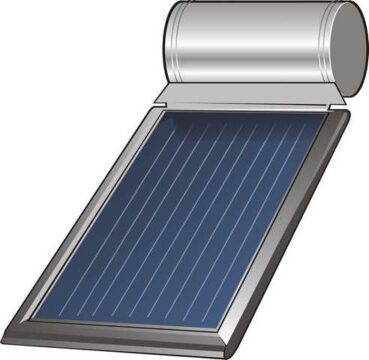
In India, there is wide use of solar energy, especially in the rural parts where it can be utilized in many ways such as:
- Cooking
- Heating
- Lighting
- Pumping
- Drying
- Rooftop Solar
Indian rural states face acute electricity shortages and sun power can rescue them in many ways.
Nowadays, building materials are smartly integrating solar energy for multiple uses.
In fact, it can have multiple uses in our daily life which includes solar-powered consumer products such as solar watches, calculators, chargers, fans, chimneys, radios, notebooks, etc.
4. Reduced Electricity Bill
By using rooftop solar you are not going to be dependent on the power distribution companies anymore.
Do you know that according to a latest study in India, the current cost of solar power is almost 20-30% below the cost of traditional thermal power?
Yes, That’s right.
According to a current study by TERI, the projected cost of solar power in 2030 would be anywhere between Rs 1.9-2.3 per kWh whereas the traditional coal power could be as expensive as Rs 4.85 to 6.98 per kWh.
So the decision is yours!
You can save a hefty amount of your hard-earned money on electricity bills just by installing solar panels.
More and more power generation from the rooftop solar system can help you to cut down your electricity costs drastically.
There is also a possibility to get payments for the surplus energy produced from the rooftop solar energy system that you are exporting back to the grid.
5. Government Support & Subsidy
To promote sustainable growth and overcome India’s energy security challenges, the government is encouraging people to adopt solar energy on a large scale.
The Indian government is offering tax credits and subsidies on various solar products to promote them and keep them affordable.
According to the Ministry of New and Renewable Energy:-
| Solar Equipment | Capacity | Subsidy |
| Rooftop solar installations | up to 3 kW | 40% |
| Rooftop solar installations | above 3 kW, and up to 10kW | 40% for the first 3kW and 20% for the remaining 7 kW |
| Rooftop solar installations | above 10 kW | No Subsidy |
| Solar Pumps | pump capacity up to 7.5 HP | 30% (State Dependent) |
Apart from central government subsidies, the various state government offers additional subsidies on solar products.
For example, In Uttar Pradesh an additional subsidy of Rs 15,000 per kW to be provided to residential consumers.
Thus we can say it is the right time to switch towards solar energy.
6. Low Maintenance Costs
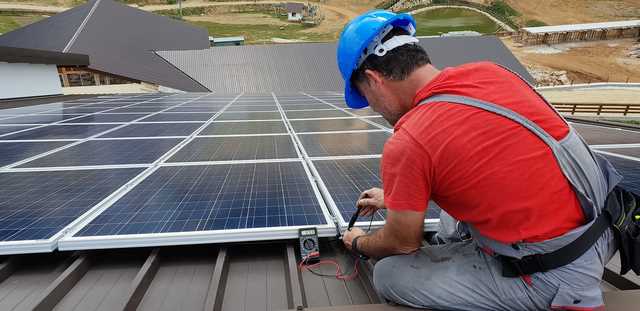
Solar systems generally require less maintenance, they are durable having a longer lifespan.
There is negligible wear and tear due to the absence of moving parts.
Solar PV cells may look relatively fragile but it is protected by an upper layer of shatter-proof tempered glass which cannot easily break.
Normally, solar-powered equipment such as rooftop panels has a service life span of 20-25 yrs if maintained properly.
You can also think about taking an insurance plan while purchasing a solar system if you are worrisome.
The prime maintenance requirement is to keep the solar energy systems clean.
You also have to ensure that the Inverter system (converts solar energy into electricity) is changed after 5-10 years and the cables are in perfect condition to get maximum efficiency.
There are many Solar O&M companies in India that will do your job on a yearly basis at a nominal charge of 1500-2500 Rs/kW
7. Works in any climate (Most Suited to Indian Climate)
If you think that solar panels work only in ample sunshine and would not work on cloudy days you may be wrong.
Solar-powered equipment creates electricity during all daylight hours irrespective of the weather.
Solar energy systems work best in India as we are situated at an ideal geographical location that receives sufficient tropical sunlight (300 sunny days /year approx.)
8. Secure Investment making you Completely Independent
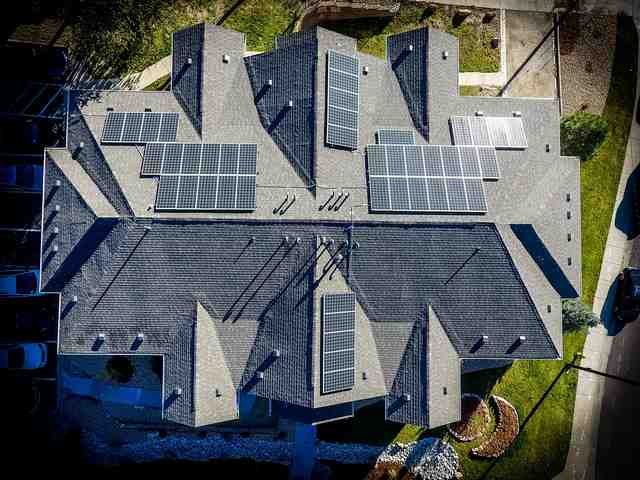
With solar energy, you no more bound to the fluctuating power tariffs that give you complete control over your expenditure.
In terms of power generation and usage, you need not worry about frequent power failure.
Solar-powered homes can get a high return on investment as potential buyers like a more efficient home that produces its own energy.
9. Easy to Install
Solar panels and related equipment look very bulky but you don’t need to buy any additional land for setting them up.
A solar-powered system can be easily installed on your rooftop or occupies a very small piece of land in case of pumping equipment.
The installation time is very less and your system would be ready within a day or two.
10. Futureproof
Solar technology is constantly improving and advancing day by day.
The competition will further intensify in the future and technological innovations will increase the effectiveness of solar energy systems.
Solar power is now coming under the mainstream market as prices are dropping very fast due to technological advancements.
Thus we can say, solar energy is the future.
Disadvantages of Solar Energy in India
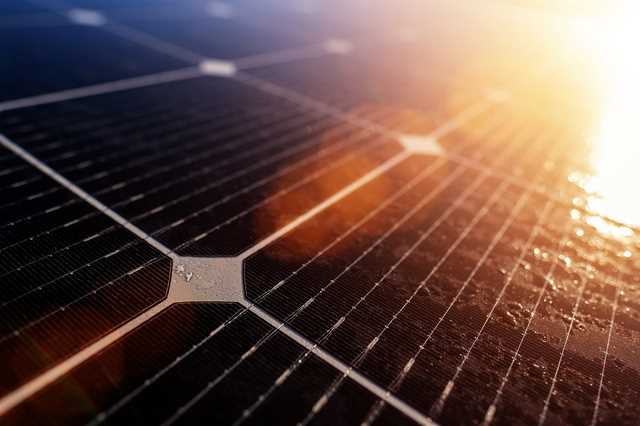
1. Initial Cost of Investment is Quite High
The initial purchase cost of certain solar equipment such as rooftop solar is fairly high but in the long run, you will reap the benefits.
The cost is fixed on the type of system you are installing.
For example, an on-grid solar energy system is a lot cheaper than an off-grid solar system due to the absence of batteries.
According to a website loomsolar, 2 kW off-grid solar system for Home with battery backup cost Rs 199000 whereas 2 kW grid-connected Solar AC Module cost Rs 160000 only.
Nowadays, the Indian government is also promoting them by providing many incentives and due to technological development, the prices will come down in the future.
2. Low Efficiency
Systems dependent on sun power are less efficient.
But you may think, what does solar efficiency mean?
In simple terms, solar efficiency tells you how much sun’s energy any panel can convert into usable electricity.
It means that if the efficiency of any solar panel is 15% then it will convert only 15 % of sunlight into electricity.
Most Solar energy systems available today can convert 15-25% of the available sun’s energy into useful power approximately.
However, the roof style, facing, slant adjustment can vary the incident sunlight onto the solar panel and can alter its efficiency.
3. Proper Location, Climate, and Availability of Sunlight
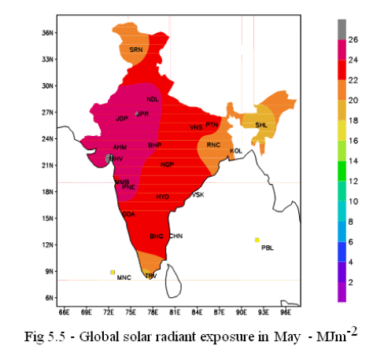
To get maximum efficiency from any solar power system latitude and location is the main deciding factor.
You can refer to the figure above which states that the northwestern region of India receives more solar radiation than the eastern counterparts in the month of May.
Varying seasons could affect the solar efficacy and power generation could vary according to the seasons.
It doesn’t mean that in winter or rainy days solar panels are unable to produce power, however, their efficiency is slightly reduced.
Other environmental factors like temperature fluctuations, wind, hail, snow, and dirt can also affect the integrity of solar equipment.
If you have a north-facing home or there are trees or tall buildings nearby then you may certain issues.
In that case, you can carry out a detailed survey well in advance to ensure the perfect type of solar system is installed at your location.
4. Inefficient Customer Services
Although many solar companies are mushrooming day by day in India the quality of customer support still requires an upgrade.
As the solar industry grows in India, the role of these service providers would become much prominent.
With better manufacturer warranties, easy annual maintenance contracts, and reliable customer support the quality of solar installations will improve drastically.
The use of advanced communication technologies and innovative business models can satisfy every need of the customers in a better way.
5. Space Limitations
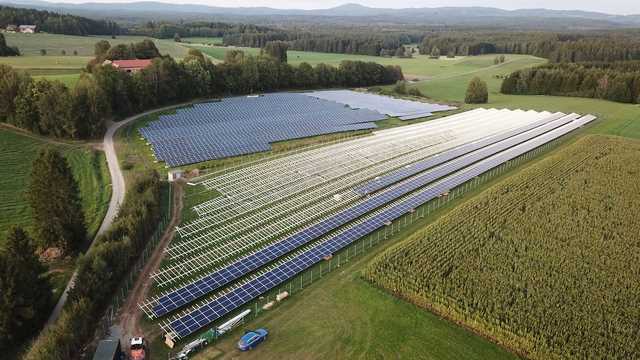
Although different capacities of solar equipment are available in the market, large-scale commercial utilization is a bit difficult due to space limitations.
It is true that small space is required for small and noncommercial usage (1 – 5 KW) but more energy requirement (>10 KW) needs large space commitment.
A Commercial solar plant requires huge land space that remains occupied for many years and cannot be used for other purposes.
For Example, World’s largest solar park is located in Bhadla (near Jodhpur), Rajasthan, India that spans over a total area of 14,000 acres (56.5 Sq Km).
Also, people living in apartment buildings can face difficulty in the installation of solar energy systems due to limited space availability.
6. Storage is Costly
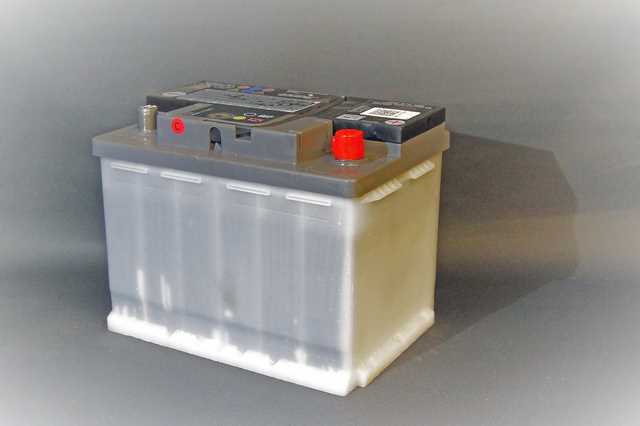
You have to either use the sun power immediately or purchase additional batteries for their storage.
Solar energy generation is not possible during the night time so using an off-grid solar system with batteries can do the job.
For getting uninterrupted solar power this is a good solution but proves quite expensive.
Energy demand is usually higher (tariffs are also higher) during the daytime so it is a smart idea to use an on-grid solar energy system at that time.
Conclusion
In India, solar energy is becoming a popular and cost-effective alternative to fossil fuels.
Harnessing sun power improves sustainability, causes low environmental impact, and promotes energy independence.
Solar power has certain advantages and disadvantages and knowing about them can help you find the best solar-powered systems as per your need.
Solar technology is still in the nascent stage but continuous technological advancements prove that the future of solar energy is very bright.
What do you think about the future of solar energy in India?
Please provide your comments below and share this article to help others.
To join the Save Environment bandwagon consider subscribing bharatgogreen.
References:–
- Vineeth A. V. Murthy, India’s Solar Energy Future, Policy & Institutions (2014), CSIS
- Ministry of New and Renewable Energy (MNRE)
- Saleem, Engr & Mehmood, Kashif & Rashid, Faizan. (2019). The Efficiency of Solar PV System.
- Economic times- Solar News